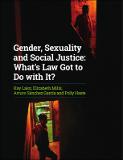Gender, Sexuality and Social Justice: What's Law Got to Do with It?
| dc.contributor.author | Lalor, Kay | |
| dc.contributor.author | Mills, Elizabeth | |
| dc.contributor.author | Sánchez García, Arturo | |
| dc.contributor.author | Haste, Polly | |
| dc.date.accessioned | 2016-02-03T14:16:55Z | |
| dc.date.available | 2016-02-03T14:16:55Z | |
| dc.date.issued | 2016-02 | |
| dc.identifier.citation | Lalor, K.; Mills, E.; Sánchez García, A. and Haste, P. (2016) Gender, Sexuality and Social Justice: What's Law Got to Do with It?, Brighton: IDS | en |
| dc.identifier.uri | https://opendocs.ids.ac.uk/opendocs/handle/20.500.12413/8878 | |
| dc.description.abstract | The contributions to this Edited Collection reveal the complexity of the deceptively simple question posed by its title: Gender, Sexuality and Social Justice: What’s Law Got to Do With It? Many of those involved in this publication are directly involved in and affected by the issues to which the Edited Collection’s title speaks. From activists working with women in Assam’s tea gardens in India or young lesbian, gay, bisexual and transgender leaders in Vietnam, to lawyers fighting the Anti-Homosexuality Bill in Uganda or the criminalisation of cross-dressing in Malaysia, to academics carefully re-reading Islamic Sharia or researchers assessing HIV prevention programmes in South Africa, the contributors to this Collection have first-hand knowledge and experience of the complexities of gender, sexuality and social justice. The product of this vast array of experience is a series of conversations that decisively indicate that the question of law’s relation to sexuality, gender and social justice does not have a single, simple answer. The increased legalisation of processes by which sexual, sexuality and gender justice is sought requires interrogation and careful scrutiny and, as the contributions in this collection show, the law is often an imperfect tool for achieving meaningful justice. Yet it is in these important and complex conversations that the scope for future action becomes tangible. In exploring different processes by which activists and other actors have worked for change, in interrogating what we mean when we talk about ‘solidarity’, and in questioning the usefulness and place of law, a picture of a complex but vibrant field of action for sexuality and gender justice begins to emerge. This Collection offers multiple routes to sexuality and gender justice and numerous suggestions of what sexuality and gender justice could be in a plurality of contexts. It also suggests that there are many potential pitfalls and barriers to justice or progress. What this Collection highlights, however, is that by listening carefully to each other and by paying careful attention to the needs of those working on the ground, we give ourselves the best chances of success, individually and collectively. The ongoing conversations in this Collection are part of this process. It has been a privilege to be part of them and we will watch how they develop further with interest and with hope. | en |
| dc.description.sponsorship | UK Department for International Development | en |
| dc.publisher | IDS | en |
| dc.relation.ispartofseries | Edited Collection; | |
| dc.rights | All photographs in the Edited Collection are attributed on the back cover. Permission to reuse the photographs must be sought from the individual publishers. Infographics on pp.103–104 by Joe Wheeler. Please seek permission to reuse these infographics. | en |
| dc.rights.uri | http://creativecommons.org/licenses/by/4.0/ | en |
| dc.subject | Gender | en |
| dc.subject | Sexuality and Development | en |
| dc.title | Gender, Sexuality and Social Justice: What's Law Got to Do with It? | en |
| dc.type | Other | en |
| dc.rights.holder | IDS | en |
| dc.identifier.ag | OT/11009/6/1/4/415 |
Files in this item
This item appears in the following Collection(s)
Except where otherwise noted, this item's license is described as All photographs in the Edited Collection are attributed on the back cover. Permission to reuse the photographs must be sought from the individual publishers.
Infographics on pp.103–104 by Joe Wheeler. Please seek permission to reuse these infographics.


